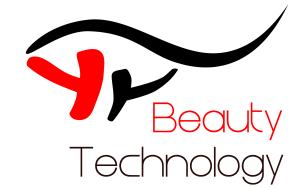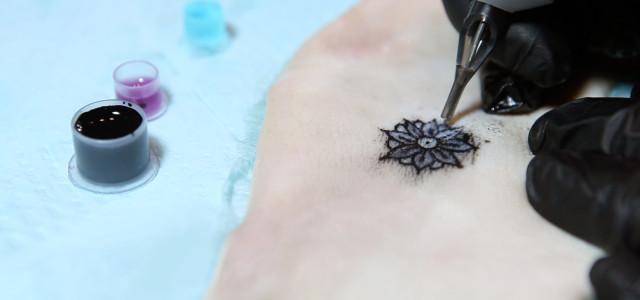Can tattoos embrace technology in order to make the skin interactive? The DermalAbyss project is the result of a collaboration between MIT researchers Katia Vega, Xin Liu, Viirj Kan and Nick Barry and Harvard Medical School researchers Ali Yetisen and Nan Jiang. DermalAbyss is a proof-of-concept that presents a novel approach to bio-interfaces in which… Continue reading →
http://dl.acm.org/citation.cfm?id=2890270
Beauty Technology is a wearable computing paradigm that uses the body’s surface as an interactive platform by integrating technology into beauty products applied directly to one’s skin, fingernails and hair. Hairware is a Beauty Technology Prototype that connects chemically metalized hair extensions to a microcontroller turning it into an input device for triggering different objects.… Continue reading →
Our aim is to use our own bodies as an interactive platform. We are trying to move away from traditional wearable devices worn on clothes and accessories where gestures are noticeable and remind cyborg looking. We follow Beauty Technology paradigm that uses the body’s surface as an interactive platform by integrating technology into beauty products… Continue reading →
Tags: IUI 2015
Our aim with Beauty Technology is to transform our body in an interactive platform by hiding technology into beauty products for creating muscle based interfaces that don’t give the wearer a cyborg look. FX e-makeup is a Beauty Technology prototype that applies FX makeup materials embedded with electronics for sensing the face’s muscles. This work… Continue reading →
As wearable technology assumes an increasingly important function in daily life, sensors and other electronic devices applied directly to the skin, in forms like artificial nails and makeup, might further revolutionize human experience. Katia Vega, Hugo Fuks, “Beauty Technology: Body Surface Computing,” Computer, vol. 47, no. 4, pp. 71-75, Apr. 2014, doi:10.1109/MC.2014.81 Read more: http://www.computer.org/csdl/mags/co/2014/04/mco2014040071-abs.html
Looking for wearables that are fashionable, smart and augment human interaction, we introduce the term Beauty Technology as an emergent field in Wearable Computing. It is an on-body computing approach that turns non-invasive, wireless and without power required electromagnetic devices into beauty products for interacting with different surfaces and devices. This paper describes the materials… Continue reading →
Este artigo apresenta uma abordagem sistemática de prototipação colaborativa para a criação de tangíveis. Durante quatro períodos letivos, esta abordagem foi aplicada em uma disciplina para calouros de Engenharia, na qual os alunos trabalharam em grupos no desenvolvimento de tangíveis para um jogo pré-definido, resultando em um total de 22 protótipos de alta fidelidade. Os… Continue reading →
Wearable Computing had changed the way individuals interact with computers, intertwining natural capabilities of the human body with processing apparatus. But most of this technology had been designed just for clothing or accessories and it is still flat and rigid, giving the wearer a cyborg look. Beauty Technology, based on electromagnetic devices that are embedded… Continue reading →
Just blink and levitate objects, just move your fingernails and open the door. Chemically metalized eyelashes, RFID nails and conductive makeup are some examples of Beauty Technology products, an emergent field in Wearable Computers. Beauty Technology embedded electromagnetic devices into non-invasive beauty products that could be attached to the human body for interacting with different… Continue reading →
The evolution of Wearable Computers is making it possible for wearers to move and interact freely with the world with nearly invisible technology embedded into clothing. Our aim is to create technology that is not just in clothing but on the skin surface as removable and hidden electronics. In this paper, we introduce the term… Continue reading →
Imagining the future, we create sci-fi predictions visualized through telematic imagery, involving stage sets and costumes. Looking back at sci-fi’s imagination we find it depicts the ideologies of the period in history when it was created far more accurately than it manages to predict future materials or functions. This article focuses on the body, but… Continue reading →
The Cybernetic Serendipity exhibition in 1968 [1] and the Computer in Art book in 1971[2] represent some remarkable initial approaches in collaborative art-technology projects. Over the years, projects have evolved through thinking influenced by other areas such as psychology, sociology and philosophy. Much of art theory and practice is exploratory and its outcomes may be… Continue reading →
Touch, sight, smell, hearing and taste – our senses link us to the outside world. Reflexes react to all stimuli arriving simultaneously to our sensory environment. But there are lapses in awareness of seemingly obvious stimuli to temporary losses of attention and lapses that we are not aware of in the form of reflexes. The… Continue reading →
The main motivation of this research is to gain a better understanding of the power of feedback loops by finding the zone somewhere between passively offering information and aggressively pumping out data that gets ignored along with all the other media noise. The answer we believe lies in creating compelling, aesthetic solutions that appeal to… Continue reading →
During the last 5 years, research on Human Activity Recognition (HAR) has reported on systems showing good overall recognition performance. As a consequence, HAR has been considered as a potential technology for e-health systems. Here, we propose a machine learning based HAR classifier. We also provide a full experimental description that contains the HAR wearable… Continue reading →
This paper describes a systemic approach to co-design of collaborative museums, using ethnography, co-creation workshops and fast prototyping, amongst other Social Science and Human Centered Design methods. Focused on the creation of immersive and collaborative museum experiences, it provides a rationale for involving carefully selected multidisciplinary teams and users in the entire design cycle, and… Continue reading →
Este artigo apresentada a arquitetura xAgent, cuja finalidade é o desenvolvimento de ambientes cross-reality colaborativos. xAgent se baseia em um sistema multiagentes no qual a comunicação entre os agentes se restringe a ocorrência de eventos no mundo real e virtual. São apresentados dois protótipos de aplicações, xGroupware e Ubilife, que ilustram a implementação da arquitetura… Continue reading →
This paper presents xGroupware, a cross-reality application to support distance group work, in which some activities related to the coordination of meetings are systematized. xGroupware was developed with a Multiagent System-based architecture that integrates different technologies to enable message exchanges between users in the real and virtual worlds through the use of wearable computers. Vega,… Continue reading →
The paper presents a human centered approach to co-design of groupware and socialware for collaborative museums, using ethnography, co-creation workshops and Blank Model Prototyping. It discusses the concepts and processes of human centered design, participatory design, ethnography, concept generation and iterative prototyping – pointing their value to the support of group systems design, in comparison… Continue reading →
This position paper outlines the authors’ vision on how the Web of Things, using interconnected devices, including sensor nodes, mobile phones and conventional computers can help improve the overall health and wellbeing of its users. We describe ongoing work being carried by our research group both at PUC-Rio and at Lancaster University as well as… Continue reading →
This paper presents xGroupware, a cross-reality meetingware that coordinates some activities to support remote workgroup. xGroupware was developed based on a multiagent system architecture that integrates different technologies for enabling message exchange between virtual and real worlds users using wearable computers. Vega, K.; Cardador, D.; Fuks, H.; Lucena, C.J.P. Anais do XIII Symposium on… Continue reading →
TREG is a training game which simulates various activities in software requirements workshop technique based on the book “Requirements by Collaboration”. It was developed in Second Life, a virtual world that gives the possibility to create an immersive collaborative educational experience. This study evaluated TREG using the usability metrics for games: interface, game mechanisms and… Continue reading →
TREG is a game for training in Requirements Engineering, specifically in the Workshops technique. It was created in Second Life using its building and scripting possibilities. This works presents an exploration in the use of a prototyping process and techniques for developing the game. The prototyping process of the book “Effective Prototyping for Software Makers”… Continue reading →
This work presents a collaborative educational game,Time2Play, developed in Second Life, which allows t he creation ofstories in a collaborative fashion, offering a new form of expression in education. This game is projected for children from7 to 12 years old,enabling them to express their creativity and imagination by creating andenacting stories of their own. The… Continue reading →

